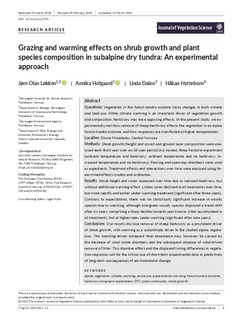Grazing and warming effects on shrub growth and plant
Peer reviewed, Journal article

Åpne
Permanent lenke
http://hdl.handle.net/11250/2597106Utgivelsesdato
2019Metadata
Vis full innførselSamlinger
- Scientific publications [1392]
Originalversjon
10.1111/jvs12752Sammendrag
Questions: Vegetation in the forest–tundra ecotone faces changes in both climate
and land‐use. While climate warming is an important driver of vegetation growth
and composition, herbivory may have opposing effects. In the present study, we experimentally
test how removal of sheep herbivory affects the vegetation in an alpine
forest–tundra ecotone, and how responses are manifested at higher temperatures.
Location: Dovre Mountains, Central Norway.
Methods: Shrub growth (height and cover) and ground layer composition were analysed
each third year over an 18‐year period in a nested, three‐factorial experiment
(ambient temperature and herbivory; ambient temperature and no herbivory; increased
temperature and no herbivory). Fencing and open‐top‐chambers were used
as expedients. Treatment effects and interactions over time were analysed using linear
mixed effects models and ordination.
Results: Shrub height and cover increased over time due to reduced herbivory, but
without additional warming effect. Lichen cover declined in all treatments over time,
but more rapidly and earlier under warming treatment (significant after three years).
Contrary to expectations, there was no statistically significant increase in woody
species due to warming, although evergreen woody species displayed a trend shift
after six years, comprising a sharp decline towards year twelve. Litter accumulated in
all treatments, but at higher rates under warming (significant after nine years).
Conclusions: Our results disclose removal of sheep herbivory as a prominent driver
of shrub growth, with warming as a subordinate driver in the studied alpine vegetation.
The warming‐driven increased litter abundance may, however, be caused by
the decrease of wind inside chambers and the subsequent absence of wind‐driven
removal of litter. This chamber effect and the displayed timing differences in vegetation
responses call for the critical use of short‐term experimental data in predictions
of long‐term consequences of environmental change.